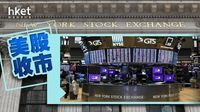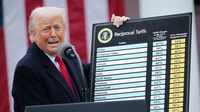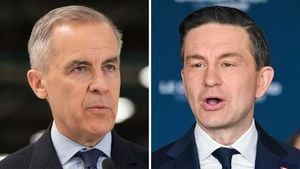The United States is set to impose a staggering 104% tariff on Chinese imports starting April 9, 2025, at 12:01 AM Eastern Time, which translates to noon in Hong Kong. This unprecedented move comes as the U.S. seeks to address ongoing trade tensions with China, marking a significant escalation in the trade war between the two nations. The announcement has already sent shockwaves through the financial markets, with the Dow Jones Industrial Average (DJIA) experiencing a tumultuous day of trading.
On the day prior to the tariff's implementation, the DJIA plunged by as much as 861 points, hitting a low of 37,103 points. By the close of trading, it had settled down 320 points to 37,645. The S&P 500 and Nasdaq also saw significant declines, with the S&P falling 1.6% to 4,982 and the Nasdaq dropping 2.2% to 15,267. Major tech stocks were not spared; Apple (AAPL) fell by 5%, Tesla (TSLA) by 4.9%, and Nvidia (NVDA) by 1.4%.
White House Press Secretary Karoline Leavitt emphasized that the U.S. government believes China's retaliatory measures against U.S. tariffs are misguided. She stated, "When the U.S. is hit, the president will strike back harder," underscoring the administration's resolve to proceed with the tariff increase as planned. Trump has made it clear that if China wishes to negotiate, they must initiate contact first. "China must call first," he said, indicating a willingness to engage in dialogue but only under favorable conditions for the U.S.
Trump's aggressive tariff strategy follows a series of previous increases, including a 20% tariff imposed on Chinese goods in February and March and a subsequent 34% tariff announced on April 2, 2025. In retaliation, China has vowed to impose its own tariffs on U.S. goods, which are expected to take effect shortly after the U.S. tariffs.
The economic implications of these tariffs are profound. U.S. Treasury Secretary Steven Mnuchin stated that the U.S. holds a clear advantage in the ongoing trade war, noting that U.S. exports to China account for one-fifth of China's exports to the U.S. He asserted that the purpose of these tariffs is to bring trading partners to the negotiating table and restore job opportunities in the U.S.
As the prospect of a trade war escalates, nearly 70 countries have reportedly reached out to the U.S. in hopes of negotiating trade agreements tailored to their specific circumstances. Leavitt mentioned that Trump has instructed his trade team to develop customized agreements for each country, ensuring that they are beneficial for American workers and industries.
However, the looming tariffs have raised concerns about their impact on the global economy. Analysts warn that if the tariffs are fully implemented, U.S. corporate profits could shrink by about 15%, and the price-to-earnings ratio of U.S. stocks may compress further by 10%. In a pessimistic scenario, the S&P 500 could fall to approximately 4,500 points.
Investors are already feeling the effects of the tariff announcements. Following the news, the U.S. stock market experienced a sharp decline, with the DJIA falling by 1,703 points at one point during the trading day. The volatility has investors on edge, with many turning to safe-haven assets amid fears of a recession.
In addition to the tariffs on China, the European Union is also considering imposing retaliatory tariffs on a range of U.S. goods, including soybeans and nuts, further complicating the international trade landscape.
Despite the challenges, some business leaders close to Trump are beginning to urge a reassessment of the current approach. They warn that continued escalation could lead to broader economic repercussions, including increased consumer prices. A recent poll indicated that three-quarters of Americans expect prices to rise as Trump's tariff policies take effect.
As the situation develops, the White House remains firm in its stance, insisting that negotiations will prioritize allies such as Japan and South Korea while downplaying immediate talks with China. The global financial markets will continue to react to these developments as traders brace for the impact of the new tariffs.
In summary, the U.S. is poised to implement a historic 104% tariff on Chinese imports, a move that has already destabilized financial markets and raised concerns about potential economic fallout. With negotiations underway with other trade partners and a firm stance against China, the coming days will be critical in shaping the future of international trade relations.






